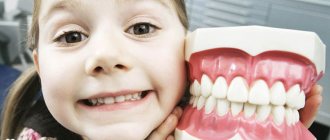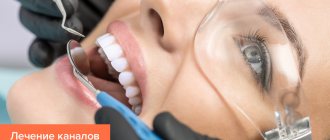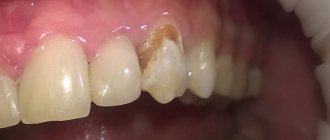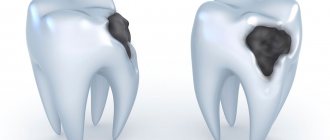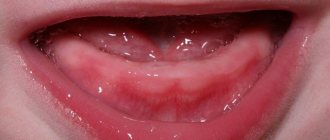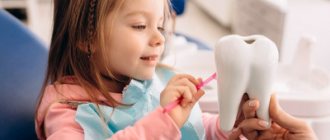- Questions and answers
- Stock
- Reviews
| Prices | Is it important to treat childhood caries? | Symptoms | Stages of caries | Treatment methods |
Caries of primary and permanent teeth occurs in 70-80% of children. This is due to the fact that children do not take good care of their oral hygiene and are partial to sweets. Do I need to treat the first teeth that will have to be removed anyway? What treatment methods are used in dentistry? How much does it cost to treat caries in children at the NovaDent clinic?
Prices
| Baby teeth | Price |
| Treatment of milk caries with placement of a filling made of glass ionomer cement | 2 350 ₽ |
| Treatment of caries with light polymerization fillings | 3 500 ₽ |
| Treatment of initial and superficial caries with Icon | 3 500 ₽ |
| Baby teeth | Price |
| Treatment of caries with filling made of glass ionomer cement | 2 350 ₽ |
| Treatment of caries with light polymerization fillings | 3 500 ₽ |
| Treatment of initial and superficial caries with Icon | 3 500 ₽ |
| Permanent teeth | Price |
| Temporary filling | 300 ₽ |
| Medical pad | 550 ₽ |
| Treatment of caries with placement of a light polymerization filling (anesthesia, cavity formation, antiseptic treatment, filling) | 2500 – 4 500₽ |
| Tooth restoration | 5 500 ₽ |
| Permanent teeth | Price |
| Temporary filling | 300 ₽ |
| Medical pad | 550 ₽ |
| Treatment of caries with placement of a light polymerization filling (anesthesia, cavity formation, antiseptic treatment, filling) | 2500 – 4 500 ₽ |
| Tooth restoration | 5 500 ₽ |
You can make an appointment with a pediatric therapist by multi-line phone or online on the website.
In our center, pediatric dentistry operates in the following clinics:
- Bratislavskaya, VDNKh, Verkhniye Likhobory, Krasnogorsk, Oktyabrskoye Pole, Petrovsko-Razumovskaya, Skhodnenskaya
Why is it necessary to treat childhood caries promptly?
- Deep dental caries in children can provoke dangerous complications, pulpitis and periodontitis, acute pain and loss of a dental unit. And due to the fact that young children are not able to tolerate pain, treatment of the disease in an advanced stage must be carried out under general anesthesia or sedation.
- The rudiments of permanent units are located under the milk ones. Serious infections and early removal of primary teeth can lead to dental problems in adulthood.
- Dairy milk is more porous in its structure, so caries in children progresses faster. If treatment is not started on time, after 3-6 months a small carious spot can lead to deep caries and pulpitis.
To detect the disease at an early stage, visit the pediatric dentist once every 3-4 months.
Why does caries occur in childhood?
It is known that caries is a pathological process that occurs in the hard tissues of teeth under the influence of internal and external factors. Carious lesions arise as a result of the “work” of cariogenic bacteria living in the oral cavity.
In this article
- Why does caries occur in childhood?
- Features of caries of milk teeth
- Symptoms of carious lesions in baby teeth
- Why is caries treated for young children?
- How is caries treated in children?
- Methods for treating childhood caries without drilling
- Invasive treatment of caries
- Do they give anesthesia to children?
- Prevention of childhood caries of primary teeth
By processing carbohydrates that enter the mouth with food, these bacteria produce acid. It is this that contributes to the destruction of enamel, dentin and other tooth tissues. Several factors contribute to the proliferation and active activity of cariogenic bacteria, which ultimately leads to the development of caries in children.
- Improper dental hygiene.
Insufficient cleaning from plaque, infrequent cleaning.
- Eating high in carbohydrates.
Children who eat a lot of sweets and flour, drink sweet compotes at night, and snack on chocolates are more susceptible to developing caries. A favorable breeding ground for microbes is formed in their mouth.
- Reduced immunity.
Weakened immune defense does not allow the body to effectively resist negative influences, so children with weak immunity develop caries more often.
- Features of intrauterine development.
The formation of teeth occurs in the first trimester of pregnancy, and it can be affected by the lifestyle, health, and previous diseases of the expectant mother.
These factors contribute to the fact that tooth enamel begins to lose mineral substances, cariogenic microbes multiply in the mouth, and as a result, dental caries develops.
Symptoms of the disease
A child cannot always point out the source of pain and discomfort, so parents need to be especially attentive to their child’s behavior and monitor the condition of the oral cavity. The following symptoms should alert you:
- Refusal to eat, tearfulness while eating;
- Chewing food on only one side of the jaw;
- Painful sensations from hot, cold and sweet;
- Yellow or white spots, dark streaks on tooth enamel;
- Bad breath.
If you observe one or more of the signs listed above in your child, contact your dentist immediately.
What is bottle caries?
There is another type of childhood caries - bottle caries. It occurs in children after the eruption of baby teeth, when the baby is breastfed or bottle-fed. This disease usually occurs as a result of feeding a child before bedtime. While he sleeps, bacteria begin to multiply in his mouth.
Often this form of carious process affects the cervical area. Gradually, caries spreads along the entire circumference of the crown. First, white spots appear, then they darken and destroy dentin. The child constantly cries, especially during meals, sleeps poorly and tries to refuse food. This indicates increased sensitivity of the enamel. Left untreated, it can lead to premature loss of baby teeth.
Stages of caries
There are 4 stages of caries in primary teeth.
Elementary
– the stage of a carious stain is characterized by softening and demineralization of the enamel. The tooth surface loses its uniformity and becomes rough with white or light brown inclusions. At this stage, caries is asymptomatic.
Surface
– the destruction of the outer shell of the tooth continues, the shade of the enamel deteriorates, the nerve begins to react to temperature stimuli, sweet foods and drinks.
Average
– bacteria penetrate into the inner layers of the tooth, and the upper layers of dentin begin to deteriorate. At this stage, the carious cavity is clearly visible. Sensitivity to hot, cold and sweets increases.
Deep
– the infection spreads and affects an increasing proportion of dentin. At this stage of the disease, the risk of complications increases, including tooth loss.
Complications
The enamel of baby teeth is not strong enough, and therefore even minor damage to the tooth by caries can lead to rapid destruction of tooth tissue. The most common complication of caries in primary teeth is pulpitis. As a rule, the disease is chronic and appears even in the presence of small carious cavities. Only a dentist can identify the disease, since despite the inflammatory process, the child does not experience discomfort for a long time.
If pulpitis is not treated, the complication develops into a more complex form; the infection affects the tissues surrounding the tooth root - periodontitis develops. Parents should regularly take their child for preventive examinations to the dentist, since advanced caries of baby teeth can lead to serious complications and cause the death of the permanent tooth germ.
Features of caries treatment in children
The dentist must treat small patients with care and choose the most gentle and painless treatment possible. In dental therapy for children, the doctor follows the following rules:
- The duration of the appointment is no more than 30 minutes
. - , application anesthesia
is mainly used , less often - infiltration anesthesia (injection). For pain relief, the same drugs are used as for adults, only in smaller doses. - Treatment of caries in young children is carried out without drilling
using gentle methods: fluoridation and the infiltration method (with the drug Icon). - To remove deep caries in children under 3 years of age, filling with glass ionomer cement or photopolymer composite is used, usually under general anesthesia or sedation.
What to do if a child does not allow or is afraid to have his teeth treated?
Many children experience panic, so it is very important to intelligently approach the question of how to properly persuade a small child to have their teeth treated. To make the process painless and, perhaps, even positive, adhere to the following rules:
- Meet the doctor.
This should be done not at the moment when the tooth is already sick, but in advance - during a preventive examination.
- Motivation.
The child does not know why this is needed and what awaits him in general, so you should tell him about the importance of the procedure or, for example, show him in a playful way on his favorite toy.
- Elimination of physical force.
If a child resists, is capricious and protests, he should not be forced into the dental chair. This will not only traumatize the psyche, but will also completely discourage you from visiting dentists. Here it is better to act carefully - persuade, talk about the great benefits of treatment, or offer a new toy as a present.
- Timing.
If treatment is required, you should see a doctor without delay, but you should also consider the child’s needs. If he is used to, for example, sleeping at a certain time, you should not go to the doctor at that very moment. This is fraught with bad mood and whims. First, let your child sleep, and only after that get ready for the dentist. The same goes for eating, playing and other hobbies.
- Do not lie.
Many parents say that the doctor will only look and do nothing. This is a very big mistake, because the child expects one thing, but in the end it turns out something completely different. It will be better if you tell him the truth in a positive way.
Another good way to motivate your child is by example. If you regularly visit a doctor for preventive purposes and talk about the benefits of procedures, then your child will follow your example.
Treatment methods for caries of primary teeth
Initial and superficial caries of baby teeth can be treated without a drill. In young children, carious stains on tooth enamel are effectively removed by infiltration using the unique German Icon technology. Fluoridation is also widely used.
Treatment without drilling with Icon
The technique consists of applying a special paste to a previously dried surface, which restores the enamel and stops the development of caries. Icon is completely painless and does not require anesthesia.
Indications:
usually carried out 6 months after the complete eruption of a particular tooth, suitable for children over 2 years old.
Fluoridation
Treatment of the tooth surface with fluoride-containing pastes with calcium, which restore enamel. Remineralization is an effective, painless and absolutely safe procedure. Thanks to fluoridation of children's teeth, the enamel layer becomes denser and less vulnerable to the negative effects of bacteria and acids, which cause dental caries.
Indications:
used from an age when the child is able not to swallow the medicinal solution.
Fissure sealing
The essence of the method is filling grooves and tubercles on the tooth surface with special fluorine-containing materials. The technique protects against the penetration of pathogenic bacteria into the tooth and reduces the likelihood of caries by 90%. Fissure sealing is carried out in two ways: invasive and non-invasive.
Indications:
It is advisable to carry out no later than 2.5-3 years.
Important:
All treatment procedures are carried out only after professional cleaning of baby teeth.
Read more about the treatment of baby teeth.
How to prepare your child for treatment
It's no secret that children are afraid of dentists, and without reason. Today, dental procedures are performed quickly and painlessly. You just need to prepare your baby for treatment so that he doesn’t worry. Find a good specialist. Some doctors turn the treatment process into an interesting game and thereby distract the child from terrible thoughts.
Practice your visit to the dentist at home. Soft toys can also act as “patients”. Tell your child that both mom and dad go to the dentist. Choose a time to visit the clinic when your baby is alert and cheerful. Make up a story about how a doctor saves teeth from monsters. Never scare children with hospitals or doctors when they misbehave.
Check your child's teeth every few months. Get him used to brushing them twice a day. Buy a special children's brush with soft bristles. To make it more interesting for him to take care of his teeth, you can choose a brush stylized as a cartoon character. Similar hygiene products are available in our online store.
Treatment of caries of permanent teeth in children
At the initial stage, caries of permanent teeth can also be cured without drilling or preparation. The same methods are used as in the treatment of primary teeth. Sealing the fissures of molar teeth is recommended as the most effective prevention of caries.
Filling is the main method of treating permanent teeth in children. Filling technology for children is practically no different from therapy for adults. For restoration in this case, photopolymer composites of the latest generation are more often used.
The permanent tooth is filled according to the following scheme:
- Preparation, cleaning of carious cavity;
- Treatment with an antiseptic drug;
- Restoration with photopolymer composite;
- Polishing and grinding of the filling.
Tooth restoration is carried out under local anesthesia. Doses are selected individually depending on the age of the child.
Special offer
Participate in the promotion
Promotion “1+1”: child and parent
You have entrusted NovaDent with the treatment of your child’s teeth, as a token of gratitude we are giving you a free consultation with any specialist (surgeon, implantologist, therapist, orthodontist, hygienist), as well as an orthopantomogram (panoramic photograph of the teeth) sent by email.
Take time for your health and take advantage of this great offer! Participate in the promotion
Expert of the article you are reading: Lapshina Maria Aleksandrovna Dentist, pediatrician
21 years
Clinical experience
Krasnogorsk
Moscow region, Krasnogorsk, Podmoskovny Boulevard, 5
+7
Free consultation with this specialist

